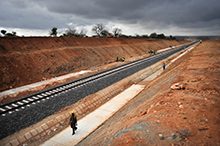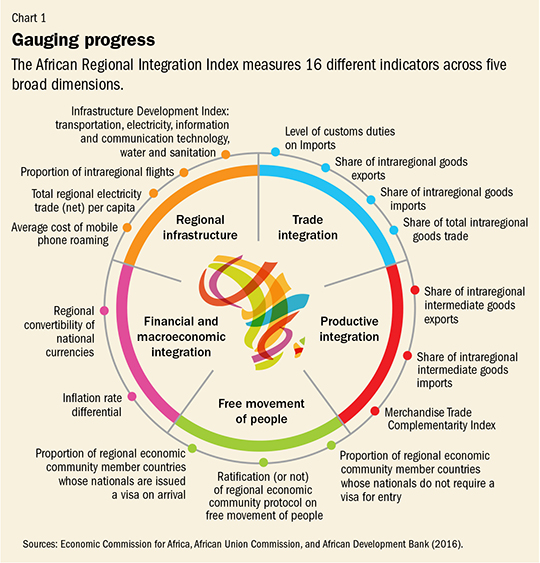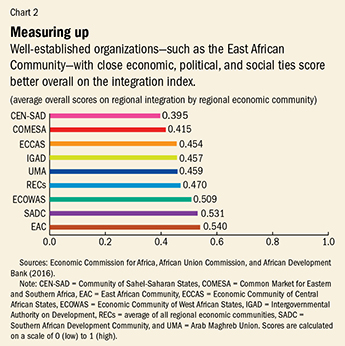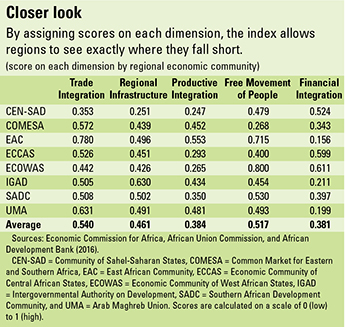Inching toward Integration
Finance & Development, June 2016, Vol. 53, No. 2

A new index allows African countries to see how their regional integration efforts stack up
It costs more to move a container from Kenya to Burundi than from Belgium or the United Kingdom to Kenya. Twenty percent of Africa’s international infrastructure networks, such as the Trans-African Highway network, are impassable. Flight connectivity is the lowest in the world and centered on only about 328 hubs for a land mass of around 1.7 million square miles, making it time consuming and costly to travel between African countries (United Nations Statistics Division, 2016).
Although the pan-African ideal has been part of the continent’s modern history since the struggles for independence in European-ruled African territories in the 1950s and 60s, African leaders never succeeded in translating this ideal into political capital. Attempts at real integration have so far yielded only mixed results.
A series of initiatives dating to 1980—the Lagos Plan of Action, the Abuja Treaty, the New Partnership for Africa’s Development, and the more recent Agenda 2063—were each heralded as the economic response to Africa’s need for a new, more interconnected future. Why is it proving to be so painfully difficult to implement this vision of a truly integrated continent?
Broader perspective needed
Part of the response lies in the need for Africa’s regional integration agenda to move beyond a focus on trade alone. There is a case to be made for a much broader perspective. Just as important as the variety of what is on offer at the local market is how easily citizens move between countries, where individuals travel for leisure or for work, how cost-effective telecommunications are, where people choose to study or look for a job, and even how they transfer money to their family or get start-up capital for a business.
Yet few policymakers focus on this bigger picture when considering policies to boost integration.
The continent’s regional economic communities are one tangible sign of progress on integration. Regional economic communities are the building blocks of the African Economic Community established by the 1991 Abuja Treaty, which provides the overarching framework for continental economic integration.
These country groups include the Arab Maghreb Union and the Community of Sahel-Saharan States in the north, the Economic Community of West African States (ECOWAS) in the west, the East African Community (EAC) and the Intergovernmental Authority on Development in the east, the Southern African Development Community (SADC) in the south, the Common Market for Eastern and Southern Africa (COMESA) in the southeast, and the Economic Community of Central African States in the center.
The regional economic communities are taking concrete steps toward integration. For instance, in mobile telecommunications, they are now applying innovative measures to reduce the cost of mobile roaming through closer cooperation. This is particularly true in the EAC. In January 2015, Kenya, Rwanda, South Sudan, and Uganda launched the East Africa One Area Network in a bid to harmonize regional calling rates and lower costs between partner states. Recent estimates suggest that mobile phone traffic grew by 935 percent within three months of the launch, while the cost of making calls fell by over 60 percent.
But critical challenges remain. Formal intra-African trade in goods is 14 percent, compared with 17 percent for South and Central America, 42 percent for North America, 62 percent for the European Union, and 64 percent for Asia. And Africa’s largest economies still trade on a most-favored-nation basis.
These are just a few examples of how far the continent has to go before it is truly integrated. While policymakers have designed integration frameworks, their implementation has been hampered by the absence of monitoring and evaluation mechanisms. Simply put, there was until recently no means of measuring, in a precise and objective way, which countries are making the most progress in deepening regional integration, in which areas individual countries are falling behind, and which policies and institutions have proved most effective in promoting integration.
Quantifying integration
To fill this gap, the African Union, the African Development Bank, and the Economic Commission for Africa have launched the African Regional Integration Index, which presents a cross-border and multidimensional view of integration.
The index measures five different dimensions: trade integration, , productive integration, free movement of people, and financial and macroeconomic integration. These dimensions build on an overview of the key socioeconomic factors that are fundamental to integration. Sixteen categories, cutting across the five dimensions, are used to calculate the index (Chart 1).

Trade integration. The free movement of goods is key for trade growth. Businesses and people benefit when trade flows are faster and more cost-effective. But in Africa, trade links to the rest of the world are more direct and efficient than trade between neighboring regions because of infrastructure gaps or capital costs and nontariff barriers.
Regional infrastructure. Infrastructure development across the continent is the most visible face of regional integration. It includes highways being built across borders, flights taking passengers from one capital to another, and more people using mobile phone roaming on city streets or rural outposts. Countless connections made by road, by air, or increasingly by airwaves have an important impact on Africa’s integration efforts. Better regional infrastructure means lower transaction costs and faster delivery of goods and services, so regional hubs—as well as small or landlocked countries—have a lot to gain from promoting infrastructure to boost economic growth.
Productive integration. Central to Africa’s economic success is the need to increase production and productivity. Africa could do more to develop regional and global value chains, which means fostering more diverse and resilient economic bases. As consumer purchasing power rises, intermediate goods that are used by a business in the production of finished goods or services will be important for Africa’s internal market. Building industrial clusters goes together with access to regional trade corridors that get goods moving and with promoting more regional electricity to power production. Whether for agriculture or industrial production, regions need to unlock their productive potential, inject investment, overcome bottlenecks, and make sectors more competitive.
Free movement of people. Cross-border movement represents not only a powerful boost to economic growth and skills development, it also supports competitiveness. Free movement of people benefits both the country opening its borders and the country whose citizens are on the move, as is evident in the growth of remittances in recent years. For many African countries, migration can plug skills gaps and allow the exchange of ideas, leading to the expansion of entrepreneurship and innovation beyond borders.
Financial and macroeconomic integration. When capital flows more freely, investment increases, finance is allocated where it is most productive, and the continent’s investors get higher returns. In turn, as the transaction costs of doing business fall and financial institutions work more effectively, micro, small, and medium-sized enterprises and start-ups will benefit. Better financial integration promotes knowledge and technology transfer as well as greater innovation.
Practical, results-focused tool
Both a status report and an energizer for change, the index aims to be an accessible, comprehensive, practical, and results-focused tool that emphasizes policies and on-the-ground realities. It is designed to provide policymakers at the national, regional, and international levels; businesses; and other stakeholders reliable data that rank countries and institutions in various categories and dimensions, showing strengths and weaknesses. The goal is to enable action.
The index—in its first edition—focuses on comparative analysis within and among the regional economic communities, with the aim of taking into account the diversity in Africa’s integration efforts. It allows each community to identify its strengths and gaps across each of the five dimensions.

Several important findings have emerged from initial analysis. Africa’s overall regional integration across the regional economic communities stands below the halfway mark on the scale that ranges from no integration at all to fully integrated on all dimensions (see Chart 2). This shows that the overall integration in the region has significant potential to progress. The EAC comes out as the most integrated regional community overall, followed by the SADC and ECOWAS.
Part of the reason the EAC does so well may be related to pre-independence history, when the core of the EAC was run as the East African Federation by the British with shared governance, traditions, and institutions. With recent strong political commitment at the highest level, the current phase of east African integration—after a hiatus during the 1960s, 1970s, and 1980s—is building upon this shared history.
What can explain these differing levels of performance of Africa’s regional economic communities?
It is important to note that indicators described in Chart 1 include both “input” gauges to measure policies and “outcome” gauges that measure the value of the resulting cross-border economic flows. The highest-performing regional economic communities in the index perform well on both. This correlation between performance in the input and outcome indicators suggests that the policies measured by the former do indeed lead to better integration outcomes. In other words, EAC, ECOWAS, and SADC may perform better than the other blocs because they have implemented the pro-integration policies that are measured in the index.
While every regional economic community has a higher-than-average score in one or more dimensions, in each case the highest scores are on trade integration and the lowest on financial and macroeconomic integration. A series of actions can improve financial and macroeconomic integration, including promoting banking across borders outside the well-established financial centers; standardizing regional payments; putting in place multilateral fiscal guidelines; and converging on inflation targets, public finance, and exchange rate stability.
The regional economic communities rank closest to each other on regional infrastructure and productive integration and furthest apart on free movement of people and financial and macroeconomic integration (see table).

Results show the 28 top performing countries considered the most integrated overall across the eight regional economic communities included in the index. An additional 19 countries are considered broadly integrated. The analysis also shows that the economic weight of a country does not necessarily correspond to its regional integration score, with the exception of Kenya and South Africa. For instance, while Nigeria represents 37 percent of regional GDP, it is not a top performer on regional integration, nor is Egypt. Conversely, countries such as Côte d’Ivoire, which contributes only 3 percent of regional GDP, are among the top performers.
So what does all this mean for Africa’s integration, and does the multiplicity of regional groupings help or hinder it?
Although the index cannot directly answer this question, other research (Economic Commission for Africa, the African Union Commission, and the African Development Bank, 2012) clearly shows that Africa’s regional economic communities have been the locus of many effective integration measures, particularly in the areas of trade integration and free movement of people. While these efforts represent progress, the multiplicity of standards, rules of origin, and regimes that span the continent surely increase the burden of compliance on African businesses. Africa needs to harmonize integration policies across its various regional blocs. ■
Carlos Lopes is a United Nations Under-Secretary-General and Executive Secretary of the Economic Commission for Africa.
This article is based on the Africa Regional Integration Index Report 2016 of the Economic Commission for Africa, the African Union Commission, and the African Development Bank.
References
Economic Commission for Africa, the African Union Commission, and the African Development Bank, 2016, Africa Regional Integration Index Database (Addis Ababa).
———, 2012, Assessing Regional Integration in Africa V: Towards an African Continental Free Trade Area (Addis Ababa).
United Nations Statistics Division (UNSD), 2016, UNdata.
Opinions expressed in articles and other materials are those of the authors; they do not necessarily reflect IMF policy.


